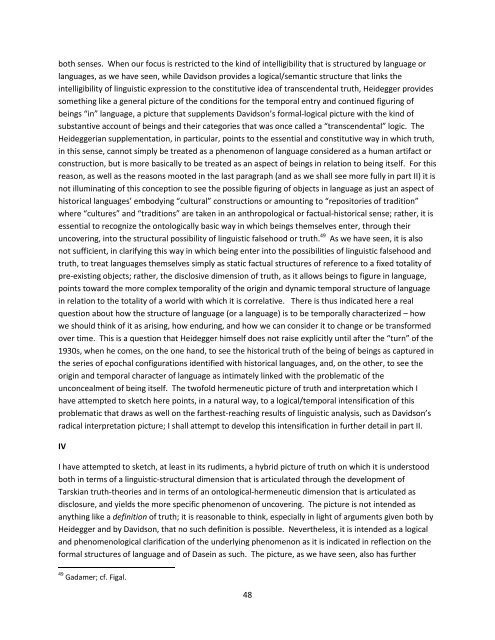Heidegger, Tugendhat, Davidson - University of New Mexico
Heidegger, Tugendhat, Davidson - University of New Mexico
Heidegger, Tugendhat, Davidson - University of New Mexico
You also want an ePaper? Increase the reach of your titles
YUMPU automatically turns print PDFs into web optimized ePapers that Google loves.
oth senses. When our focus is restricted to the kind <strong>of</strong> intelligibility that is structured by language or<br />
languages, as we have seen, while <strong>Davidson</strong> provides a logical/semantic structure that links the<br />
intelligibility <strong>of</strong> linguistic expression to the constitutive idea <strong>of</strong> transcendental truth, <strong>Heidegger</strong> provides<br />
something like a general picture <strong>of</strong> the conditions for the temporal entry and continued figuring <strong>of</strong><br />
beings “in” language, a picture that supplements <strong>Davidson</strong>’s formal-logical picture with the kind <strong>of</strong><br />
substantive account <strong>of</strong> beings and their categories that was once called a “transcendental” logic. The<br />
<strong>Heidegger</strong>ian supplementation, in particular, points to the essential and constitutive way in which truth,<br />
in this sense, cannot simply be treated as a phenomenon <strong>of</strong> language considered as a human artifact or<br />
construction, but is more basically to be treated as an aspect <strong>of</strong> beings in relation to being itself. For this<br />
reason, as well as the reasons mooted in the last paragraph (and as we shall see more fully in part II) it is<br />
not illuminating <strong>of</strong> this conception to see the possible figuring <strong>of</strong> objects in language as just an aspect <strong>of</strong><br />
historical languages’ embodying “cultural” constructions or amounting to “repositories <strong>of</strong> tradition”<br />
where “cultures” and “traditions” are taken in an anthropological or factual-historical sense; rather, it is<br />
essential to recognize the ontologically basic way in which beings themselves enter, through their<br />
uncovering, into the structural possibility <strong>of</strong> linguistic falsehood or truth. 49 As we have seen, it is also<br />
not sufficient, in clarifying this way in which being enter into the possibilities <strong>of</strong> linguistic falsehood and<br />
truth, to treat languages themselves simply as static factual structures <strong>of</strong> reference to a fixed totality <strong>of</strong><br />
pre-existing objects; rather, the disclosive dimension <strong>of</strong> truth, as it allows beings to figure in language,<br />
points toward the more complex temporality <strong>of</strong> the origin and dynamic temporal structure <strong>of</strong> language<br />
in relation to the totality <strong>of</strong> a world with which it is correlative. There is thus indicated here a real<br />
question about how the structure <strong>of</strong> language (or a language) is to be temporally characterized – how<br />
we should think <strong>of</strong> it as arising, how enduring, and how we can consider it to change or be transformed<br />
over time. This is a question that <strong>Heidegger</strong> himself does not raise explicitly until after the “turn” <strong>of</strong> the<br />
1930s, when he comes, on the one hand, to see the historical truth <strong>of</strong> the being <strong>of</strong> beings as captured in<br />
the series <strong>of</strong> epochal configurations identified with historical languages, and, on the other, to see the<br />
origin and temporal character <strong>of</strong> language as intimately linked with the problematic <strong>of</strong> the<br />
unconcealment <strong>of</strong> being itself. The tw<strong>of</strong>old hermeneutic picture <strong>of</strong> truth and interpretation which I<br />
have attempted to sketch here points, in a natural way, to a logical/temporal intensification <strong>of</strong> this<br />
problematic that draws as well on the farthest-reaching results <strong>of</strong> linguistic analysis, such as <strong>Davidson</strong>’s<br />
radical interpretation picture; I shall attempt to develop this intensification in further detail in part II.<br />
IV<br />
I have attempted to sketch, at least in its rudiments, a hybrid picture <strong>of</strong> truth on which it is understood<br />
both in terms <strong>of</strong> a linguistic-structural dimension that is articulated through the development <strong>of</strong><br />
Tarskian truth-theories and in terms <strong>of</strong> an ontological-hermeneutic dimension that is articulated as<br />
disclosure, and yields the more specific phenomenon <strong>of</strong> uncovering. The picture is not intended as<br />
anything like a definition <strong>of</strong> truth; it is reasonable to think, especially in light <strong>of</strong> arguments given both by<br />
<strong>Heidegger</strong> and by <strong>Davidson</strong>, that no such definition is possible. Nevertheless, it is intended as a logical<br />
and phenomenological clarification <strong>of</strong> the underlying phenomenon as it is indicated in reflection on the<br />
formal structures <strong>of</strong> language and <strong>of</strong> Dasein as such. The picture, as we have seen, also has further<br />
49 Gadamer; cf. Figal.<br />
48
















